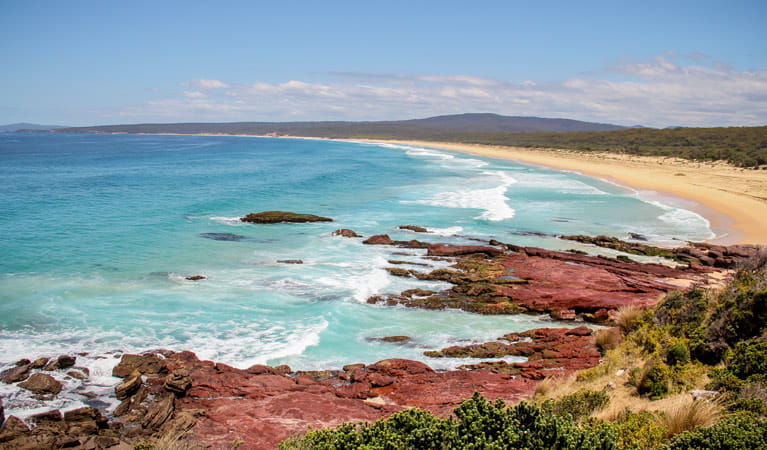Haycock Point to Barmouth Beach walking track
Pambula-Haycock area in Beowa National Park
Overview
The walk from Haycock Point to Barmouth Beach in Beowa National Park takes in whale watching, scenic coastal views, wildlife and birdwatching opportunities.
- Where
- Pambula-Haycock area in Beowa National Park in South Coast
- Distance
- 3km one-way
- Time suggested
- 1hr 30min - 2hrs 30min
- Grade
- Grade 3
- What to
bring - Drinking water, hat, sunscreen
- Please note
Remember to take your binoculars if you want to go birdwatching or whale watching
This pleasant, moderate walk leads around Haycock Point, following the headland on the southern shore of the Pambula River estuary, all the way to Barmouth Beach. Offering spectacular views and whale watching opportunities along the pristine coastline of the NSW Far South Coast, it’s an easy walk for the whole family to enjoy.
Starting at either the Barmouth Beach carpark or Haycock Point picnic area, this gently undulating walk captures the remote beauty of Beowa National Park. You’ll pass through a range of landscapes, from windswept heath to woodlands, while taking in scenic coastal views of rugged rock formations and dramatic cliff lines.
It’s a great spot for whale watching out at sea during migration. On land, you’re likely to see echidnas, kangaroos and goannas in this area.
Map
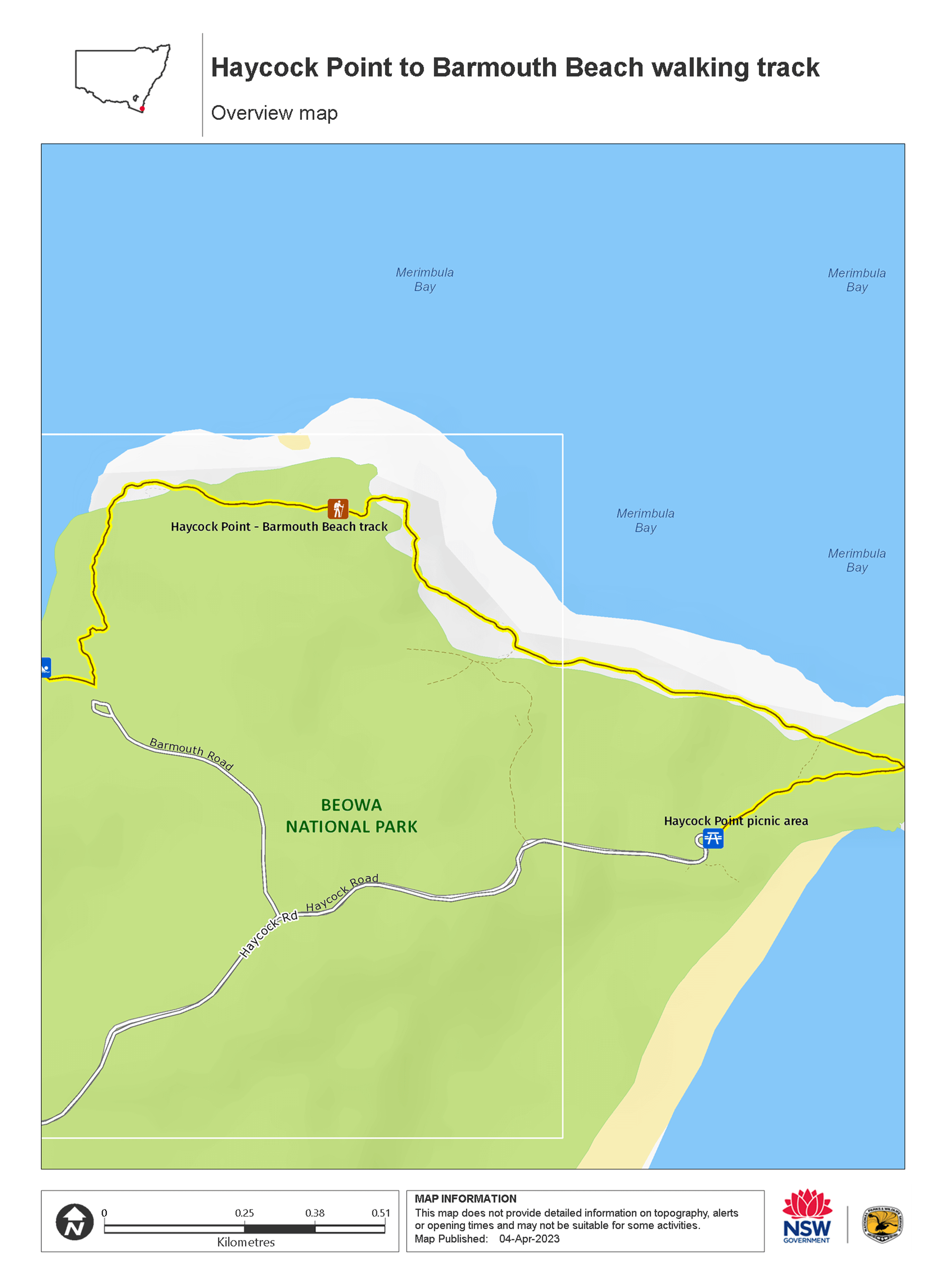
Map
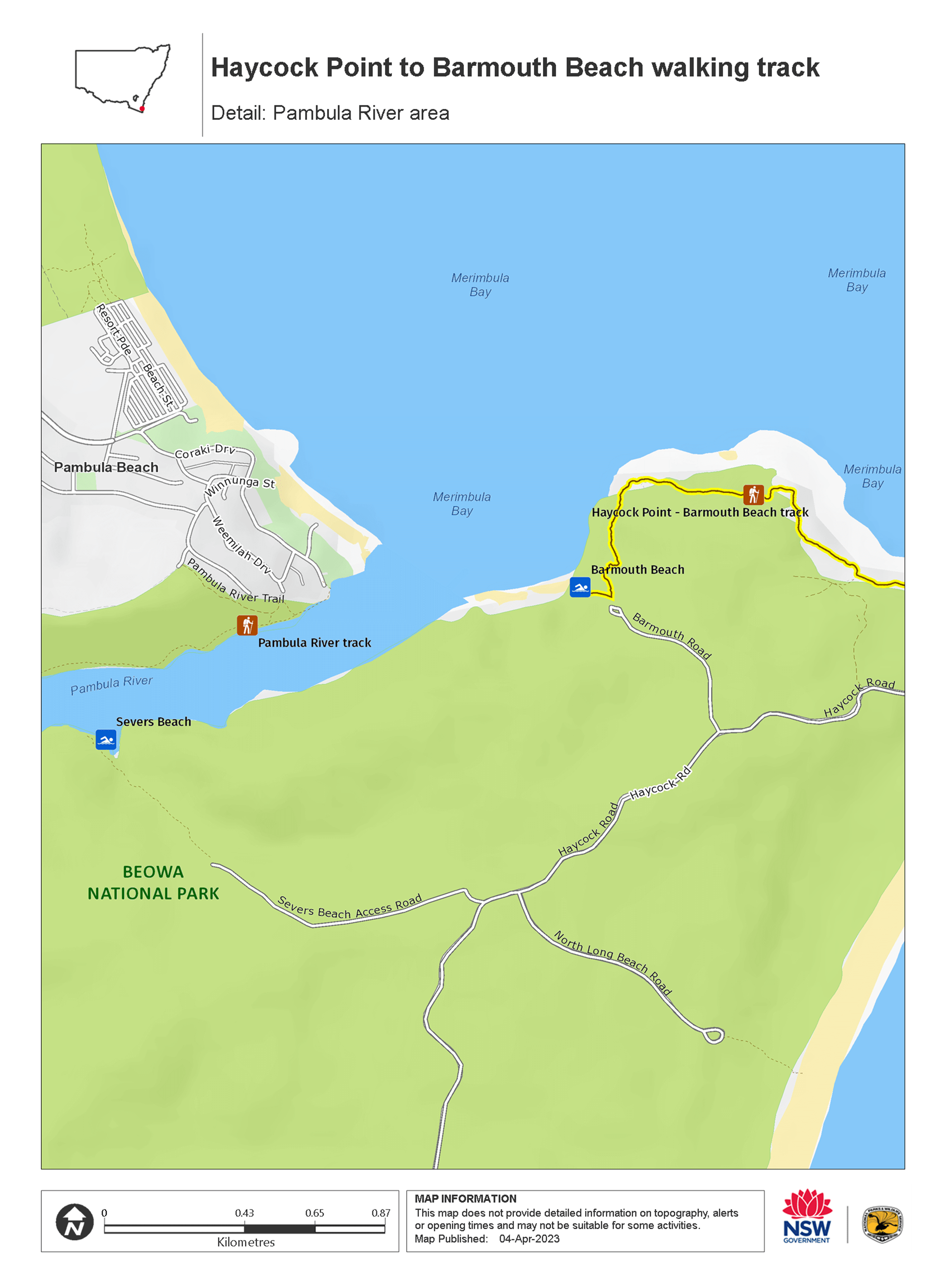
Map legend

Local alerts
For the latest updates on fires, closures and other alerts in this area, see https://www.nationalparks.nsw.gov.au/things-to-do/walking-tracks/haycock-point-to-barmouth-beach-walking-track/local-alerts
General enquiries
- National Parks Contact Centre
- 7am to 7pm daily
- 1300 072 757 (13000 PARKS) for the cost of a local call within Australia excluding mobiles
- parks.info@environment.nsw.gov.au
Park info
- in the Pambula-Haycock area of Beowa National Park in the South Coast region
The Pambula-Haycock area of Beowa National Park is always open but may have to close at times due to poor weather or fire danger.
Visitor info
All the practical information you need to know about Haycock Point to Barmouth Beach walking track.
Track grading
Features of this track
Distance
3km one-way
Time
1hr 30min - 2hrs 30min
Quality of markings
Clearly sign posted
Experience required
No experience required
Gradient
Gentle hills
Steps
Occasional steps
Quality of path
Formed track, some obstacles
Getting there and parking
Get driving directions
Haycock Point is in the Haycock Point precinct of Beowa National Park (north). To get there:
- Drive south from Pambula, 9km down Princes Highway.
- Turn left at Haycock Road – Beowa National Park.
- Drive 6km to either Barmouth Beach or Haycock Point picnic area
Parking
Parking is available at Barmouth Beach and Haycock Point.
Best times to visit
There are lots of great things waiting for you in Beowa National Park. Here are some of the highlights.
Autumn
Camp at Bittangabee Beach campground and see lyrebirds performing their characteristic dance and tail display.
Spring
Visit Green Cape Lighthouse or Boyds Tower to spot whales migrating south to their Antarctic feeding grounds - you might even see females with young calves.
Summer
Plan a camping trip to Saltwater Creek - to enjoy the lagoons and beautiful surf beach.
Winter
Take the Light to Light walk when it's nice and cool and the banksias are in bloom.
Facilities
Drinking water is not available in this area.
Maps and downloads
Prohibited
Pets
Pets and domestic animals (other than certified assistance animals) are not permitted. Find out which regional parks allow dog walking and see the pets in parks policy for more information.
Smoking
NSW national parks are no smoking areas.
Learn more
Haycock Point to Barmouth Beach walking track is in Pambula-Haycock area. Here are just some of the reasons why this park is special:
Aboriginal culture
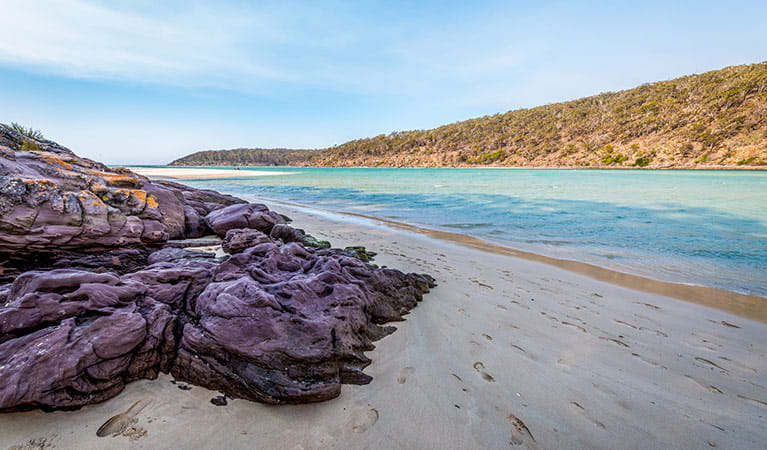
The Yuin People are the Traditional Owners and Custodians of Beowa National Park and they have a long and complex relationship with the coastal environment. Some of the best preserved mounded middens on the east coast of Australia are found in the park along the Pambula River. These middens contain the shells of oysters, mussels and sometimes the bones of sea and land mammals—collected by Aboriginal people from the rock platforms, reefs and estuaries along the park’s coastline.
- Severs Beach Severs Beach, in Beowa National Park in the whale watching town of Eden on NSW’s Sapphire Coast, offers Aboriginal heritage, fishing, beach walks and more.
Rocks tell a story
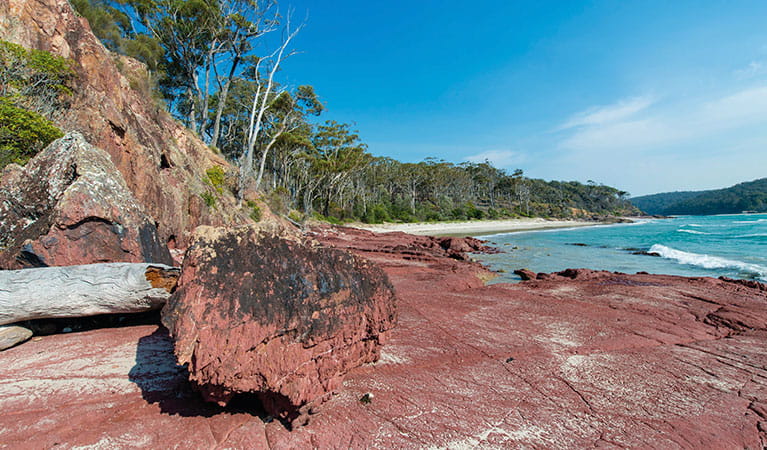
The park’s stunning rock formations, inlets and headlands are the result of extensive geological folding. Most of Beowa National Park lies on red, brown and green shales, sandstones, siltstones and quartzites. These were formed in the Devonian period around 360 million years ago, before dinosaurs roamed the earth. You can see these rock types exposed along the cliffs and headlands. The Devonian period is known as The Age of Fishes and internationally-significant fish fossils have been found in several places along the park’s coastline.
- Haycock Point to Barmouth Beach walking track The walk from Haycock Point to Barmouth Beach in Beowa National Park takes in whale watching, scenic coastal views, wildlife and birdwatching opportunities.
Refuge for threatened species
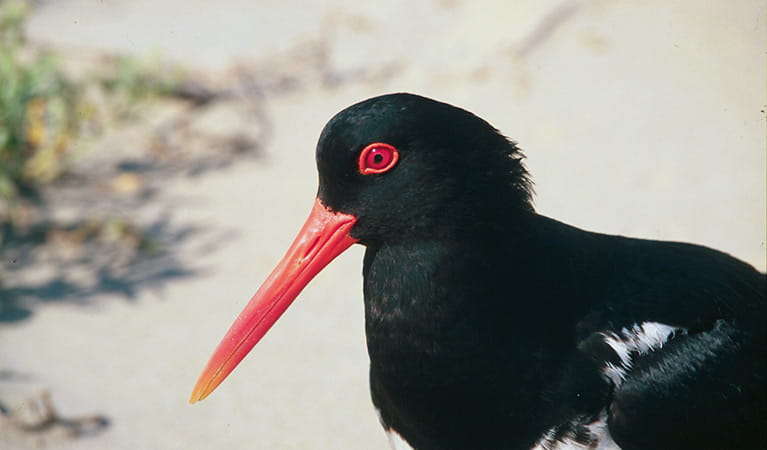
Several threatened species take refuge in the Pambula-Haycock area. North of Pambula River there's an important population of yellow-bellied gliders—listen carefully for their trademark crackles and shrieks. Around 50 native mammals and nearly 150 species of birds have been recorded in Beowa National Park. This includes 1 critically endangered bird, 4 endangered animal species and 25 vulnerable species.
- Haycock Point to Barmouth Beach walking track The walk from Haycock Point to Barmouth Beach in Beowa National Park takes in whale watching, scenic coastal views, wildlife and birdwatching opportunities.
Plants and animals protected in this park
Animals
-
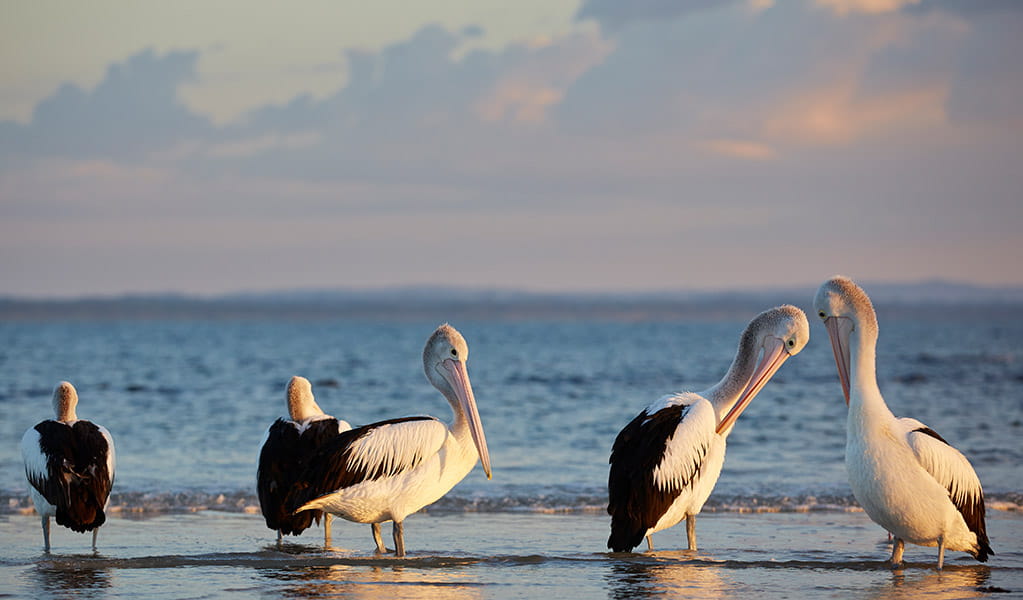
Australian pelican (Pelecanus conspicillatus)
The curious pelican is Australia’s largest flying bird and has the longest bill of any bird in the world. These Australian birds are found throughout Australian waterways and the pelican uses its throat pouch to trawl for fish. Pelicans breed all year round, congregating in large colonies on secluded beaches and islands.
-
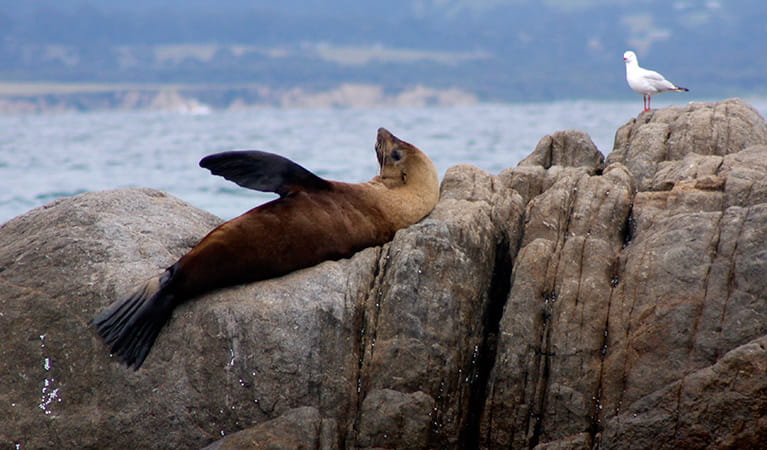
Australian fur seal (Arctocephalus pusillus doriferus)
The largest fur seal, Australian fur seals are found in isolated rocky outcrops and islands along the NSW coast. They come ashore to form breeding colonies and can often be seen at Barunguba Montague Island Nature Reserve.

